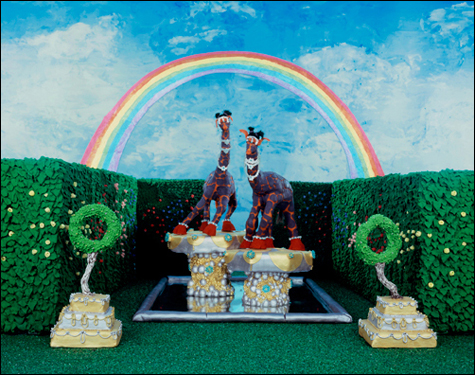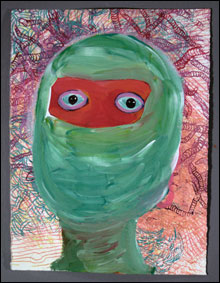Showcase sans statements
By GREG COOK | March 9, 2011

MORE! From Trachtenberg's A Decadent World series. |
One of the cool developments of the past decade has been the reassessment and historical embrace of the founding feminist art of the 1960s and '70s. Shows like "WACK! Art and the Feminist Revolution," which toured nationally in 2007; "Seductive Subversion: Women Pop Artists, 1958-1968," on view at Tufts University in Boston through April 3; and the RISD Museum's recent surveys of Lynda Benglis and Pat Steir have been well-deserved celebrations of these women's work.
They've also made plain that the centrality of video, performance, and perhaps photography in contemporary art owes much to feminist artists of the '70s. And the evidence suggests that post-modernism's interrogation of history is a direct descendent of feminist questioning of art (and world) hierarchies.
"Crossing Currents: Feminism Now" at the University of Rhode Island's Feinstein Providence Campus Gallery (80 Washington Street, through March 31) showcases more than 40 artists affiliated with two Rhode Island women artists collectives: Hera Gallery and the Hive Archive.

UNSETTLING Kovac's "semi-self portrait" Balaclava. |
Hera was founded in Wakefield in 1974 during the first wave of feminist art, when women's cooperative galleries were launched as an activist response to women being denied exhibition opportunities — and opportunities in general. Collectives like the Hive, which was founded in Providence in 2001 and has organized peripatetic talks and exhibits while talking for the past decade of converting an old gasometer building at Manton Avenue and Aleppo Street into an art center, and Providence's decade-old Dirt Palace (absent here), are representatives of riot grrrl third wave feminism, which merged punk toughness with an appreciation of traditional femininity while continuing to combat reduced opportunities for women artists compared to their male contemporaries.These days, when it comes to living artists, men still seem to get featured a bit more than women, though women outnumber men in art schools and women are the majority of curators of contemporary art. The view of "feminism now" presented in "Crossing Currents" is a widely varied art. It mainly eschews explicit feminist statements, while continuing to address the female body or traditionally female crafts like quilting or cake decorating. But mostly it's just art by women. Unfortunately, "Crossing Currents" features a lot of so-so work — which is unrepresentative of a community in which many of our best artists are women.
But do check out Lisa Gabrielle Russell's sharp, small, thickly daubed abstract paintings in greens and grays; Jen Raimondi's perhaps too-predictably-goth-but-impressively-made pink leg bone and pelvis bone sprouting little white mushrooms and curly blonde hair; and Millee Tibbs's digital photos of herself reenacting her childhood photos paired with the originals. Tibbs adopts the same outfits, expressions, and poses — with a dog or swinging in a tree — of her younger self for a funny, strange, smart reflection on girlhood versus womanhood.
 Topics
Topics:
Museum And Gallery
, University of Rhode Island, Delia Kovac, feminism, More  , University of Rhode Island, Delia Kovac, feminism, Art, RISD Museum, RISD Museum, Lynda Benglis, Pat Steir, Hera Gallery, Less
, University of Rhode Island, Delia Kovac, feminism, Art, RISD Museum, RISD Museum, Lynda Benglis, Pat Steir, Hera Gallery, Less 